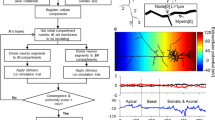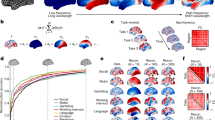Abstract
We report simulations of the electrocorticogram of the cat and human, based on estimates of fibre range, fibre density, axonal and dendritic delays, and cortical synaptic density. The long-range cortical connections of real cortex were simplified to couplings of symmetric density, decreasing in density with range, on a closed (toroidal) surface. Non-specific cortical activation was modelled as a diffuse global input and specific sensory input as a localised white noise input. Spectral properties of output included peak densities at the frequencies of the major cerebral rhythms, a ‘1/f’ spectral envelope and ‘shift to the right’ with increasing total power as non-specific activation increased. Steady-state travelling waves with a velocity of 5–7 m/s (human) and < 1 m/s (cat) were produced. Frequency/wavenumber analysis revealed an additional class of activity with wavenumbers independent of temporal frequency. All these findings accord qualitatively and quantitatively with existing physiological results. Global resonant modes were not prominent, but the simulations obey a restricted case of the analytical results of Nunez (1994). Wave/pulse relations resemble the findings of Freeman (1975).
Similar content being viewed by others
References
Amit DJ (1989) Modelling brain function. The world of attractor neural networks. Cambridge University Press, Cambridge, UK
Amit DJ, Evans MR, Abeles M (1990) Attractor neural netowrks with biological probe records. Network 1:381–405
Bok ST (1959) Histonomy of the cerebral cortex. Wiley, New York
Braitenberg V (1978) Cortical architectonics: general and areal. In: Brazier MA, Petsche H (eds) Architectonics of the cerebral cortex. Raven, New York
Braitenberg V, Schuz A (1991) Anatomy of the cortex: statistics and geometry. Springer, Berlin Heidelberg New York.
Burkitt G (1994) Steady-state visually evoked potentials and travelling waves. PhD dissertation, Swinburne University of Technology, Melbourne, Australia
De Groff D, Neelakanta PS, Sudharkar R, Aalo V (1993) Stochastic aspects of neuronal dynamics: Fokker-Planck approach. Biol Cybern 69:155–164
Eckhorn R, Bauer B, Jordon W, Brosch M, Kruse W, Munk M, Reitboeck HJ (1988) Coherent oscillation: a mechanism of feature linking in visual cortex? Biol Cybern 60:121–130
Erdi P, Grobler T, Barna G, Kaski K (1993) Dynamics of the olfactory bulb: bifurcations, learning and memory. Biol Cybern 69:57–66
Fell J, Roschke J, Beckmann P (1993) Deterministic chaos and the first positive Lyapuov exponent: a nonlinear analysis of the human electroencephalogram during sleep. Biol Cybern 69:139–146
Freeman WJ (1975) Mass action in the nervous system. Academic Press, New York
Freeman WJ (1990) On the problem of anomalous dispersion in chaoto-chaotic phase transitions in neural masses, and its significance for the management of perceptual information in brains. In: Haken H, Stadler M (eds) Synergetics of cognition. Springer, Berlin Heidelberg New York
Freeman WJ (1991) Predictions on neocortical dynamics derived from studies in paleocortex. In: Basar E, Bullock TH (eds) Induced rhythms of the brain. Birkhauser, Basel
Freeman WJ, Jakubith S (1993) Bifurcation analysis of continuous time dynamics of oscillatory neural networks. In: Aertson A (ed) Brain theory. Springer, Berlin Heidelberg New York
Gevins AS, Cuttilo BA (1994) Neuroelectric measures of mind. In: Nunez PL (ed) Neocortical dynamics of human EEG rhythms. Oxford University Press, New York
Gevins AS, Schaffer RE, Doyle JC, Cuttilo BA, Tannehill RS, Bressler SL (1983) Shadows of thought: shifting lateralisation of human brain electrical patterns during a brief visuomotor task. Science 220:97–99
Grey CM, Singer W (1989) Stimulus-specific neuronal oscillations in orientation columns of cat visual cortex. Proc Natl Acad Sci USA 86:1698–1702
Grey CM, Konig P, Engel AK, Singer W (1989) Oscillatory responses in cat visual cortex exhibit intercolumnar synchronisation which reflets global stimulus properties. Nature 388:334–337
Halpenny OS, Childers DG (1975) Composite wavefront decomposition via multidimensional filtering of array data. IEEE Trans Circuits Syst 22:552–563
Ingber L (1991) Statistical mechanics of neocortical interactions. A scaling paradigm applied to electroencephalography. Phys Rev 44:4017–4060
Ingber L, Nunez PL (1990) Multiple scales of statistical physics of neocortex: application to electroencephalography. Math Comput Modelling 13:83–95
Kaneko K (1990) Globally coupled chaos violates the law of large numbers but not the central limit theorem. Phys Rev Lett 65:1391–1394
Lagerlund TD, Sharbrough FW (1988) Computer simulation of neuronal circuit models of rhythmic behaviour in the electroencephalogram. Comput Biol Med 18:267–304
Liley DTJ, Wright JJ (1994) Intracortical connectivity of pyramidal and stellate cells: estimates of synaptic densities and coupling symmetry. Network 5:175–189
Lopes da Silva FH, Storm van Leeuwin W (1978) The cortical alpha rhythm in dog: the depth and surface profile of phase. In: Brazier MA, Petsche H (eds) Architectonics of the cerebral cortex. Raven, New York
Mitzdorf U (1988) Evoked potentials and their physiological causes: an access to delocalised cortical activity. In: Basar E (ed) Dynamics of sensory and cognitive processing by the brain. Springer, Berlin Heidelberg New York
Nunez PL (1981) Electric fields of the brain. The neurophysics of EEG. Oxford University Press, New York
Nunez PL (1989) Generation of EEG by a combination of long and short range neocortical interactions. Brain Topogr 1:199–215
Nunez PL (1994) Neocortical dynamics and human EEG rhythms. Oxford University Press, New York
Nunez PL, Srinivasan R (1993) Implications of recording strategy for estimates of neocortical dynamics with electroencephalography. Chaos 3:257–266
Picton TW, Hillyard SA (1988) Endogenous event related potentials. In: Picton TW (ed) EEG handbook. Elsevier, Amsterdam
Rotterdam A van, Lopes da Silva FH, Ende J, van der Viergever MA, Hermans AJ (1982) A model of the spatial-temporal charateristics of the alpha rhythm. Bull Math Biol 44:283–305
Sholl DA (1956) The organisation of the cerebral cortex. Wiley, New York
Silberstein RB (1994) Neuromodulation of neocortical dynamics. In: Nunez PL (ed) Neocortical dynamics and human EEG rhythms. Oxford University Press, New York
Steriade M, Gloor P Llinas RR, Lopes da Silva FH, Messulam MM (1990) Basic mechanisms of cerebral rhythmic activities. Electroenceph Clin Neurophysiol 76:481–508
Stryker MP (1989) Is grandmother an oscillation? Nature 338:97–298
Thatcher RW, Krause PJ, Hrybyk M (1986) Cortico-cortical assoications and EEG coherence: a two-compartmental model. Electroenceph Clin Neurophysiol 64:123–143
Tovee MJ, Rolls ET (1992) Oscillatory activity is not evident in the primate temporal visual cortex. Neuroreport 3:369–372
Tower DB (1954) Structural and functional organisation of mammalian cerebral cortex: the correlation of neuronal density with brain size. J Comp Neurol 101:19–52
Uttley AM (1956) The probability of neural connections. Proc R Soc Lond 142:229–241
Wilson MA, Bower JM (1989) The simulation of large-scale neural networks. In: Koch C, Segev I (eds) Methods in neuronal modelling: from synapses to networks. MIT Press, Cambridge Mass
Wilson HR, Cowan JD (1973) A mathematical theory of the functional dynamics of cortical and thalamic nervous tissue. Kybernetik 13:55–80
Wright JJ (1990) Reticular activation and the dynamics of neuronal networks. Biol Cybern 62:289–298
Wright JJ, Ihaka GR (1981) A preliminary mathematical model for lateral hypothalamic regulation of electrocortical activity. Electroenceph Clin Neurophysiol 52:107–115
Wright JJ, Kydd RR (1992) The electroencephalogram and cortical neural networks. Network 3:341–362
Wright JJ, Liley DTJ (1994) A millimetric-scale simulation of electrocortical wave dynamics based on anatomical estimates of cortical synaptic density. Network 5:191–202
Wright JJ, Sergejew AA (1991) Radial coherence, wave velocity and damping of electrocortical waves. Electroenceph Clin Neurophysiol 79:403–412
Wright JJ, Kydd RR, Lees GJ (1986) Gross electrocortical activity as a linear wave phenomenon with variable temporal damping, regulated by ascending catecholamine neurones. Int J Neurosci 33:1–13
Wright JJ, Kydd RR, Liley DTJ (1993) EEG models: chaotic and linear. Psycoloquy 4(60) eeg-chaos. l. wright.
Wright JJ, Sergejew AA, Liley DTJ (1994) Computer simulation of electrocortical activity at millimetric scale. Electroenceph Clin Neurophysiol 90:365–375
Author information
Authors and Affiliations
Rights and permissions
About this article
Cite this article
Wright, J.J., Liley, D.T.J. Simulation of electrocortical waves. Biol. Cybern. 72, 347–356 (1995). https://doi.org/10.1007/BF00202790
Received:
Accepted:
Published:
Issue Date:
DOI: https://doi.org/10.1007/BF00202790




